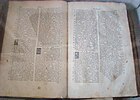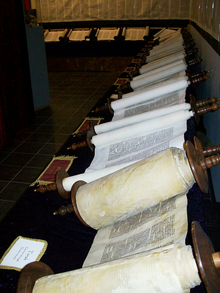Vechiul Testament
| Parte aserieidespre |
| Biblie |
|---|
 |
|
Canoane biblice șicărți |
|
Biblia creștină Vechiul Testament (VT) Noul Testament (NT) Biblia ebraică Deuterocanon Antilegomena Capitole și versete |
| Autori |
|
Scriitori Canonul ebraic Canonul Vechiului Testament Canonul Noului Testament Autori ai cărților lui Moise Epistolele Sf. Apostol Pavel Lucrările Sf. Ioan Evanghelistul Epistolele Sf. Apostol Petru |
|
Traduceriși manuscrise |
|
Torah Samariteană Manuscrisele de la Marea Moartă Text masoretic Targums·Peshitta Septuaginta·Biblia vulgata Biblia gotică·Vetus Latina Biblia luterană·Biblii în română |
| Studii biblice |
|
Datarea Bibliei Critica Bibliei Historical criticism Textual criticism Source criticism Form criticism Redaction criticism Canonical criticism Novum Testamentum Graece Ipoteza documentară Wiseman hypothesis Synoptic problem NT textual categories Coerența internă Arheolog·Artifacte Știința și Biblia |
| Interpretări |
|
Hermeneutics Pesher·Midraș·Pardes Interpretare alegorică Literalism Profeție |
| Perspective |
|
Gnostic·Islamice·Coran Christianity and Judaism Inerrancy·Infailibilitate Criticism of the Bible |
| În cultura populară |
| Ecranizări ale Bibliei |
|
|
Vechiul Testamenteste prima parte aBiblieicreștine.Conține cărțileBibliei ebraice,deși într-o ordine diferită, la care anumitebisericiadaugă și alte cărți, considerate caapocrifesaucărți deuterocanoniceîn tradiția protestantă. În bibliileprotestantecărțile apocrife nefiindcanonice,pot fi adăugate într-o secțiune separată între Vechiul șiNoul Testament.Bibliilecatoliceșiortodoxepăstrează cărțile respective în corpul canonic, considerându-le protocanonice. În funcție de conținutul canonic al Vechiului Testament, protestanții au 39 de cărți, pe când ortodocșii și catolicii au 46 de cărți biblice veterotestamentare, chiar dacă e vorba de exercitarea acelorași învățături, în cadrul aceleiași religii majore.
Text și dată[modificare|modificare sursă]
Vocalele au fost adăugate în secolul XI d.Hr.[1](în mod obișnuit ebraica se scrie fără vocale, iar textul biblic nu conținea spații sau semne de punctuație[2]).
În documentarulHistory ChannelThe Bible Unearthed(Biblia dezgropată) prof. Richard Friedman, prezentat ca autoritate mondială în materie de Biblie ebraică[3]afirmă că ea nu este o carte, ci un conglomerat de cărți, o întreagă bibliotecă[3]având între 100 și 150 de autori,[4]scrisă de-a lungul unui mileniu.[3][5][6]Data cea mai timpurie la care a început scrierea Bibliei ar putea fi 922 î.Hr., conform lui Richard Elliott Friedman.[7]Cele mai vechi manuscrise ale Bibliei sunt sulurile de argint, ele datează din 587-586 î.Hr. și sunt scrise în paleo-ebraică.[8]
În timp ce unele dintre manuscrisele biblice din Qumran sunt aproape identice cu textul masoretic, sau tradițional, ebraic al Vechiului Testament, unele manuscrise din cărțile Exodul și Samuel găsite în Peștera Patru prezintă diferențe dramatice atât în limbaj, cât și în conținut. În gama lor uimitoare de variante textuale, descoperirile biblice de la Qumran i-au determinat pe cercetători să reconsidere teoriile odată acceptate ale dezvoltării textului biblic modern din doar trei familii de manuscrise: a textului masoretic, a originalului ebraic al Septuagintei și al Pentateuhului samaritean. Acum devine din ce în ce mai clar că scriptura Vechiului Testament a fost extrem de fluidă până la canonizarea sa în jurul anului 100 d.Hr.[9]

Cărți[modificare|modificare sursă]
- Pentateuhul
- Cărțile istorice
- Cărțile poetice
- Cărțile profetice majore
- Cărțile profetice minore
- Apocrife prezente în Bibliileromano-catolică,greceștișislavone
- Cartea lui Tobit
- Iudita
- Adăugirile laCartea Esterei
- Înțelepciunea lui Solomon
- Ben Sirach(Liber Ecclesiasticus)
- Baruh
- Epistola lui Ieremia
- Adăugirile laDaniel
- 1 Macabei
- 2 Macabei
- Apocrife prezente în Bibliilegreceascășislavonă
- Apendice laVulgatașiBiblia slavonă
- Apendice laBiblia grecească
Note[modificare|modificare sursă]
- ^Baden, Joel S.The Book of Genesis: An Online Bible Study; Session 1, January 18, 2021peYouTubeYale Bible Study (Studiu biblic de laUniversitatea Yale). Citat: „Okay, now let's say you had a text of only constants that was super important, 9:43 and you wanna make sure that everyone pronounces every word exactly right. 9:48 You don't have to worry about the consonants, they've been set for years, you wanna ensure that there's no mistakes, 9:53 and that everyone's on the same page. Nobody says, on thy beginning. So the next step is obvious, 9:59 you've gotta find a way to write the vowels in among all of those consonants that are already there. 10:05 And that's exactly what happened in the 11th century AD.”
- ^Dabija, Nicoleta ().„Hermeneutica încrederii în textul biblic. Moshe Idel”(PDF).În Munteanu, Eugen.Receptarea Sfintei Scripturi.Iași: Ed. Univ. Alexandru Ioan Cuza. p. 173.ISBN978-973-640-659-1.
- ^abcBible Unearthed Discoveries of Old versions of the biblepeYouTube0:38:40-0:39:42. Citat: „Israel Finkelstein has come here to San Diego to discuss this with one of the world's leading authorities on the old testament professor Richard Friedman the situation with the Bible is not just that it's a very old book but there's a tremendous difference from the oldest part of the Bible to the youngest part of the Bible so the the first sentence in the Bible whatever that is was written a thousand years before the last sentence in the Bible and in between there's maybe a hundred or 150 authors living in this century this century this century and so even when you know Hebrew you learn it's a different Hebrew all the way through it even when you think you understand one of the authors of the Bible but there's another author of the Bible who sees things differently so people say it's not a book it's books it's not a book it's a literature it's a library people use all these metaphors to try to capture the idea that the Bible is this amazing collection over so much time professor”
- ^Bible Unearthed Discoveries of Old versions of the biblepeYouTube1:23:49-1:24:37. Citat: „but I still haven't really come to understand how it worked out so well we're not talking about one author sitting down and designing something so it comes out nicely at the end we're talking about 100-150 authors in the whole bible writing and you get a story that flows and works so well and makes such sense and has consistency in it that to me that is you know I hesitate to use the word but a miracle”
- ^Cf.„Background on Scholars”.icarusfilms.com..Arhivat din original în.Accesat în.
- ^„Free Hebrew Bible Course with Shaye Cohen”.Biblical Archaeology Society..Accesat în.
- ^Sheler, Jeffery L. ().Is the Bible True?: How Modern Debates and Discoveries Affirm the Essence of the Scriptures.HarperCollins. pp. 37–38.ISBN978-0-06-201346-0.
- ^Barkay, Vaughn, Lundberg and Zuckerman 2004 pp. 41-71
- ^Fagan, Brian M., and Charlotte Beck,The Oxford Companion to Archeology,entry on the "Dead sea scrolls", Oxford University Press, 1996.
Bibliografie[modificare|modificare sursă]
- Barkay, Gabriel; Lundberg, Marilyn J.; Vaughn, Andrew G.; Zuckerman, Bruce (). „The Amulets from Ketef Hinnom: A New Edition and Evaluation”.Bulletin of the American Schools of Oriental Research.University of Chicago Press.334(334): 41–71.doi:10.2307/4150106.ISSN0003-097X.JSTOR4150106.
Legături externe[modificare|modificare sursă]
- enCursuri despre Biblie de la Facultatea de Teologie Yale
- enCursuri despre Vechiul Testament de la Universitatea Harvard
- DeuteronomBenjamin Kilchör în Silviu Tatu (ed.)Introducere în studiul Vechiului Testament: Pentateuhul și Cărțile istoriceCluj-Napoca, Casa Cărții, 2016.
- Curmarea vieții în Vechiul TestamentArhivatîn,laWayback Machine., 12 mai 2008, Lucian Apopei,Ziarul Lumina
- Semnificațiile numelor în Vechiul TestamentArhivatîn,laWayback Machine., 28 decembrie 2008, Dr. Alexandru Mihăilă,Ziarul Lumina
- Descoperirile arheologice din Asiria și Mesopotamia, care au legătura cu datele din Vechiul Testament,22 noiembrie 2006,CrestinOrtodox.ro
| |||||||||||||||||||||||||||||||||||||||


